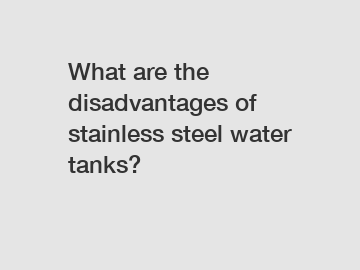What are the disadvantages of stainless steel water tanks?
What are the disadvantages of stainless steel water tanks?
Stainless steel water tanks have become increasingly popular in recent years due to their durability, corrosion resistance, and longevity. However, like any other material, stainless steel also has its drawbacks. In this article, we will explore the disadvantages of stainless steel water tanks and discuss each point in detail.
1. Cost:

One of the primary disadvantages of stainless steel water tanks is their cost. Stainless steel is a high-quality and premium material, which inevitably makes it more expensive than other tank options. The initial investment required to purchase and install a stainless steel water tank may be significantly higher compared to tanks made from other materials. However, it is important to note that stainless steel tanks often offer better long-term value due to their extended lifespan.
2. Weight:
Stainless steel tanks tend to be heavier than tanks made from other materials such as plastic or fiberglass. This can present challenges during transportation and installation. The added weight of stainless steel tanks may require additional structural support and make it more difficult to maneuver and install the tank in desired locations. Therefore, it is crucial to consider the weight limitations and suitability of your property before choosing a stainless steel tank.
3. Limited shape and size options:
Unlike plastic tanks that can be easily molded and fabricated into various shapes and sizes, stainless steel tanks typically come in standard shapes and sizes. This limitation in design can make it challenging to find a tank that perfectly fits your specific space requirements. Customized stainless steel tanks are available but often come at a higher cost. Therefore, if you have unique size and shape requirements, stainless steel tanks may not be the ideal choice.
4. Heat conductivity:
Stainless steel is a good conductor of heat compared to other materials like plastic or concrete. This means that water stored in a stainless steel tank may be more prone to temperature fluctuations. In areas with extreme weather conditions, this characteristic can potentially lead to increased energy consumption for heating or cooling the water to maintain the desired temperature. Insulation can help mitigate this issue, but it adds another layer of cost and complexity.
5. Corrosion in specific conditions:
Although stainless steel is highly corrosion-resistant, certain environmental conditions can still lead to corrosion. One common concern is the presence of chloride ions in coastal areas, which can cause pitting corrosion on the surface of the tank over time. Proper maintenance and regular inspection can help identify and prevent such issues, but it is necessary to be aware of the specific conditions that may affect stainless steel tanks and take appropriate measures accordingly.
In conclusion, while stainless steel water tanks offer numerous advantages such as durability and longevity, they also have their share of disadvantages. The higher cost, weight limitations, limited shape and size options, heat conductivity, and potential corrosion in specific conditions are all factors to consider when choosing a water storage system. It is important to evaluate your needs, budget, and environmental conditions before making a decision. Despite the drawbacks, stainless steel tanks remain a popular choice for those seeking a reliable and long-lasting water storage solution.
Want more information on can galvanized steel be used for water, spong filter, disc type air diffuser? Feel free to contact us.

Comments
0